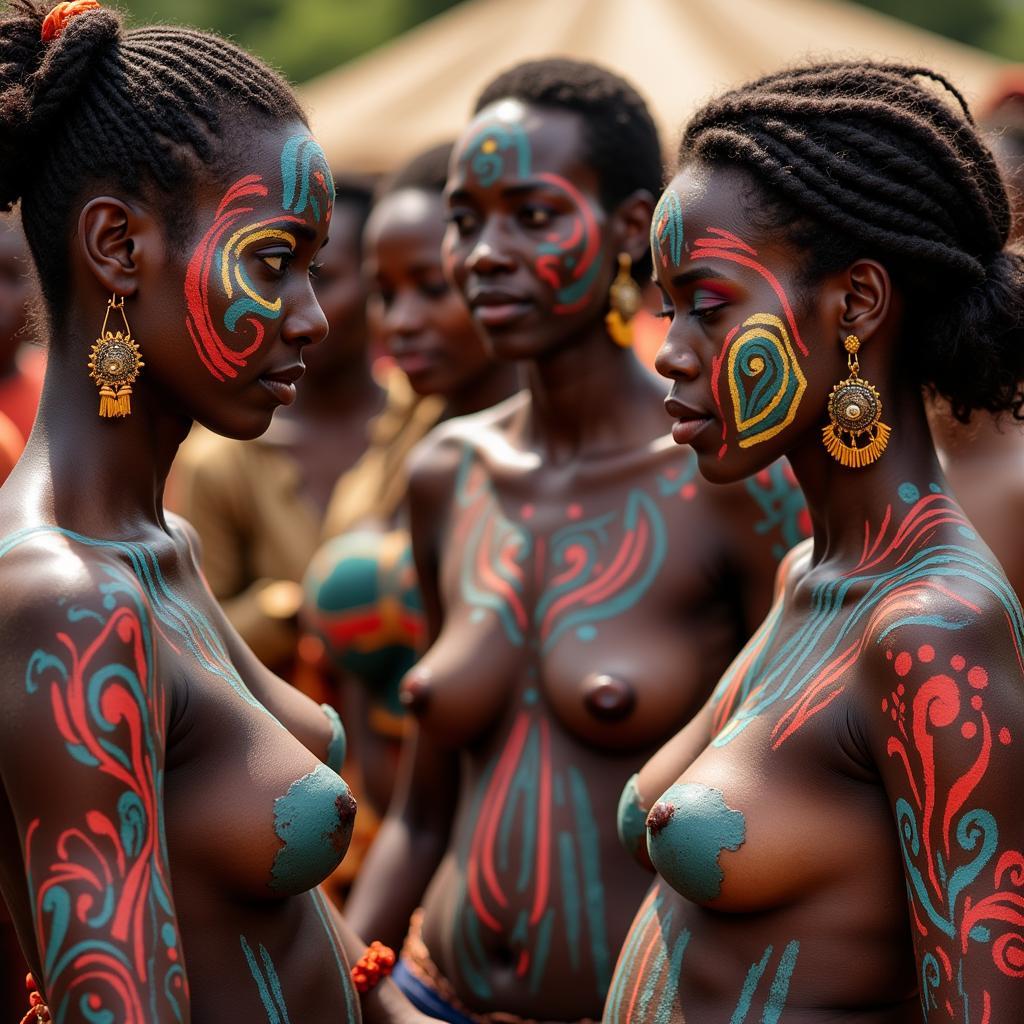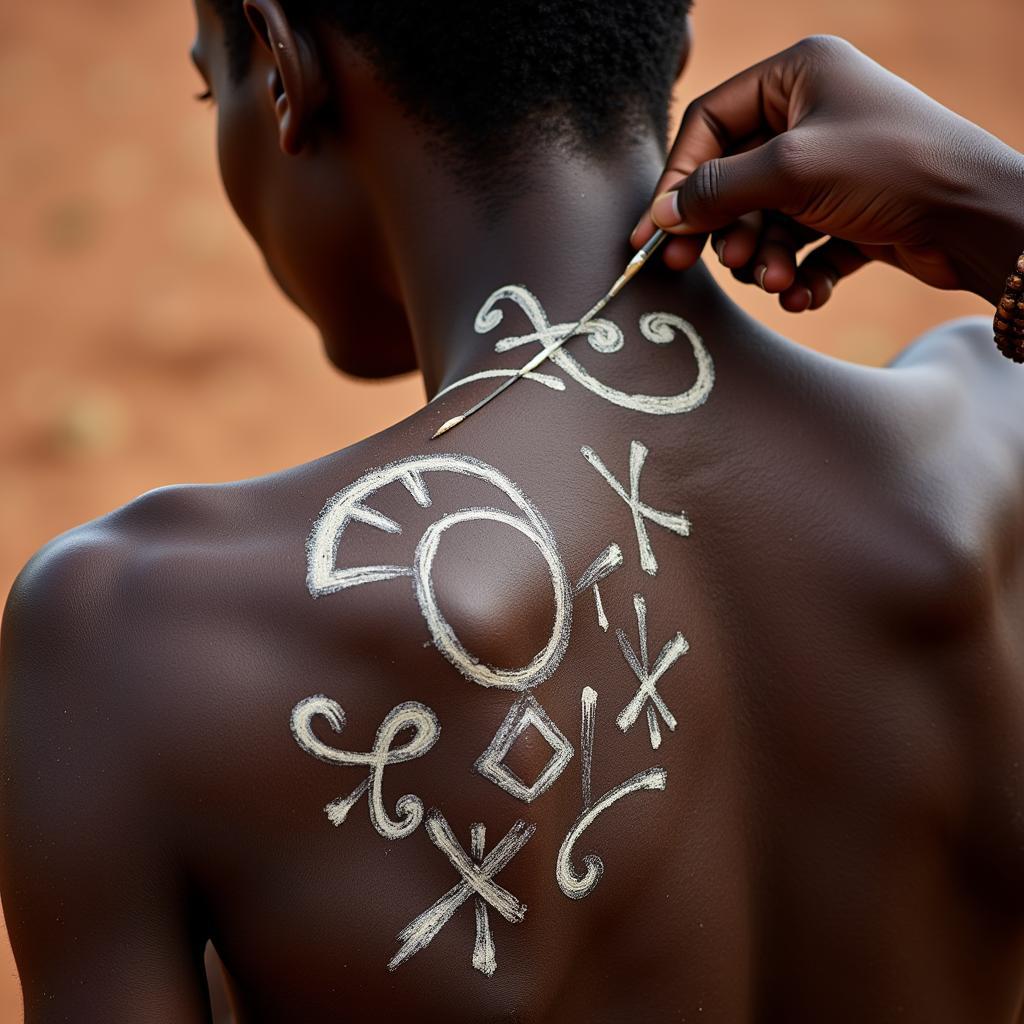Unveiling the Significance of African Chalk and Clay
African Chalk And Clay are more than just earth materials; they represent a rich tapestry of cultural practices, artistic expression, and even nutritional traditions across the diverse continent of Africa. From their use in elaborate body adornment to their role in traditional medicine, these natural resources have a profound impact on various aspects of African Life.  African women adorned with intricate chalk and clay body paintings
African women adorned with intricate chalk and clay body paintings
The Artistic Expressions of African Chalk and Clay
Chalk and clay serve as fundamental ingredients in a wide array of African art forms. For centuries, various tribes have utilized these materials to create stunning body paintings, intricate murals on homes, and symbolic sculptures. african tribes drawing These artistic traditions are often deeply rooted in spiritual beliefs and cultural narratives, with each pattern and design carrying specific meaning and significance. The vibrant colors and textures achieved with these natural pigments speak volumes about the ingenuity and artistic sensibilities of African cultures.
Chalk and Clay in Body Adornment
The use of chalk and clay in body adornment is a widespread practice across Africa. Whether for ceremonial purposes, beautification, or social messaging, these materials are applied in intricate patterns and designs that reflect the unique customs and traditions of different communities.  Elaborate chalk and clay body art for an African ceremony From the bold geometric patterns of the Himba people of Namibia to the delicate ochre designs of the Maasai in Kenya, these body art traditions are a testament to the power of self-expression and cultural identity.
Elaborate chalk and clay body art for an African ceremony From the bold geometric patterns of the Himba people of Namibia to the delicate ochre designs of the Maasai in Kenya, these body art traditions are a testament to the power of self-expression and cultural identity.
Beyond Decoration: The Practical Uses of African Chalk and Clay
Beyond their artistic applications, African chalk and clay also play a crucial role in everyday life. From building materials to medicinal remedies, these versatile resources are utilized in various practical ways. african clay This resourcefulness highlights the deep connection between African communities and their natural environment.
Chalk and Clay in Traditional Architecture
In many parts of Africa, chalk and clay are essential components in traditional architecture. These materials are used to construct homes, granaries, and other structures, providing natural insulation and protection from the elements. The distinct earthen hues of these buildings blend seamlessly into the surrounding landscapes, creating a harmonious connection between human settlements and the natural world.
The Role of Clay in Traditional Medicine
Clay has also been recognized for its medicinal properties in many African cultures. african country eating mud cake It is often used to treat various ailments, from skin irritations to digestive issues. The absorbent properties of clay are believed to draw out toxins and impurities, promoting healing and well-being.
Dr. Ayodele Ogunlana, a renowned ethnobotanist specializing in African traditional medicine, notes: “The use of clay in African medicine is a testament to the rich knowledge and understanding of natural remedies within these communities. It’s a practice deeply rooted in observation and experience, passed down through generations.”
African Chalk and Clay: A Cultural Legacy
African chalk and clay are not merely materials; they are integral components of a rich cultural heritage. From the vibrant body art of various tribes to the practical applications in architecture and medicine, these natural resources have shaped the lives and traditions of countless communities across the continent. Their continued use serves as a testament to the enduring power of tradition and the deep connection between African people and their environment. african aadiwasi model wall dizain Professor Fatima M’Boup, a leading scholar of African art and culture, adds: “The artistic and practical applications of chalk and clay offer a glimpse into the ingenuity and resourcefulness of African cultures, highlighting the deep respect and understanding of the natural world.”
Conclusion
African chalk and clay are far more than simple earth materials; they represent a vibrant tapestry of cultural expression, artistic ingenuity, and practical resourcefulness. Their significance extends beyond mere decoration, encompassing essential roles in traditional medicine, architecture, and spiritual practices. african bride and groom make up Understanding the diverse uses and cultural significance of African chalk and clay provides a deeper appreciation for the rich heritage and enduring traditions of the African continent.
FAQ
- What are the primary uses of chalk and clay in African cultures?
- How are chalk and clay used in African art?
- What is the significance of chalk and clay in traditional African medicine?
- How are chalk and clay used in African architecture?
- What are some examples of African tribes that utilize chalk and clay in their cultural practices?
- Where can I learn more about the cultural significance of chalk and clay in Africa?
- Are there any contemporary artists using chalk and clay in their work?
When you need support, please contact Phone Number: +255768904061, Email: kaka.mag@gmail.com Or visit us at: Mbarali DC Mawindi, Kangaga, Tanzania. We have a 24/7 customer support team.
